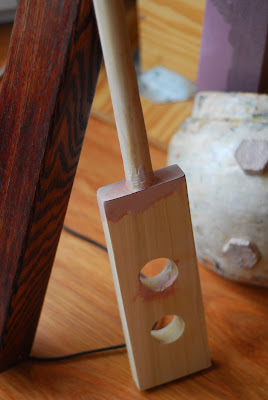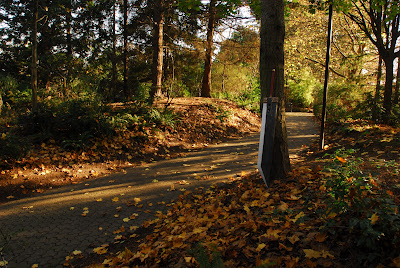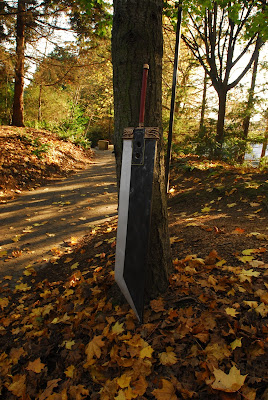[this entry is from May 2013]
I have a concern for how medical professionals learn their trade and how institutions and individuals attempt to educate them. And so now I am studying, learning, and playing in the field of medical education. This experience has been humbling. It has reminded me that I understand very little of the world around me. The opportunity to discuss ideas with people from fields of thinking different from my own has shown me how narrow my concept of reality has been. Sometime later, I intend to elaborate on this experience of having my reality challenged. But today, I am interested specifically in discourse analysis.
I am a beginner in this area, and I am initially being guided by Nicola Wood's "Describing Discourse - A Practical Guide to Discourse Analysis." I have worked my way through the introduction and first chapter. My understanding thus far is that discourse analysis refers to the careful examination of language use in real life contexts in an attempt to identify and describe what various characteristics and components of the discourse (verbal, written or otherwise) are doing. Examples of characteristics and components are such things as sound, word choice, and semantics. Perhaps this all sounds extremely boring. But it definitely is not.
In English, as is I'm sure in many other languages, we commonly say things we don't mean. It's not that we intend to lie (sometimes we do). But we expect our audience to get the intended message, even if the literal meaning of what we are saying is different. Greetings are an obvious example. The grocery store check-out conversation of "how are you today?" "good/fine, thanks," is a funny phenomenon, reminding us that the function of what is spoken is not necessarily contained in the literal meanings of the words. In fact, any word itself doesn't actually contain meaning in its own right. Any word only means whatever the speaker and the audience agree it means at that moment.
What does any of this have to do with medical education? Well, it seems we all have job-speak: the language we employ while at work. This is the way we speak to our boss, to our clients, our patients, possibly our colleagues as well. In most cases, this is noticeably different from how we speak to our friends at the bar, or the beach, or to our family at home. Why the difference? All kinds of reasons. But clearly, as a person becomes indoctrinated into a discipline, that person picks up the speech patterns of that specialty.
To be blunt, doctors do a lot of bluffing. But the practice of bluffing starts long before independent medical practice. Trainees are pressured to know the answers and be independent long before they are actually capable. And so, sometimes, they bluff. I happen to be interested in the language of this bluffing in the medical context.
Monday, August 12, 2013
Wednesday, May 1, 2013
Making Fantasy
So I like to make things, physical things. The subjects are by no means serious important things. They are simply things I like.
Below is a brief account of the making of the Buster Sword. For those who care, this build is based on a later redesign of the sword, not the original as it appeared in the 1997 Playstation game. The primary challenge of building a replica of this item is its size. The sword is meant to be roughly six feet long, ten inches wide, and one inch thick. A sword of this size made of even the lightest metal would be nearly impossible to wield. Certainly someone like me could hardly light it off the ground. So alternatives were sought.
My first attempt involved using a wooden core, with numerous holes drilled into it to reduce weight.
This was later abandoned for being too heavy still. The other components were shaped from insulation foam.
Appearing behind the sword is a wooden dummy.
This first build was too heavy, and was also mangled in the subsequent step (not shown here) in which I attempted to laminate the outside surface with fibreglass and polyester resin. The foam is delicate, and polyester resin dissolves it.
So it was onto attempt number two.
This time, I discarded the wooden core, but retained a wooden handle and part of the blade. Here, two layers of wood are laminated together.
The edges were extended and finished with Bondo, as necessary.
The handle portion was rounded. This basically involved using a hand rasp, sand paper, and patience.
The blade was once again fashioned from insulation foam, but with a cutout for the wooden paddle. The edge of the blade was shaped with sand paper.
Here the pieces were brought together, and preparations were made for fibreglassing the surface again. However, this time, I would use epoxy resin, which doesn't dissolve the foam.The sheets of fibreglass were laid on each surface sequentially, and the resin applied with a spreader. I did not create this technique; this is a common process for making surf boards.
After the resin has cured, the excess fibreglass was trimmed off. Everything sanded again.
Seen below is what would become the pommel. It was a cylinder of polyurethane plastic that I filed and sanded into the shape seen.
The opposite end of the sword, the tip, was also coated in polyurethane. This would ensure the tip would be strong enough to sustain the weight of the sword when stuck on the ground upside down. After the makeshift pour mould was removed, this tip would need to be sanded down to match the contour of the blade.
The white are pieces of styrene, often used by model train hobbyists. These were cut and shaped to form the hilt. The grey guck around the handle is a product called Apoxy Sculpt. It is applied like clay and dries hard. It can then be sanded and carved.
These are the pieces of the hilt coming together. A few steps have been skipped. The pattern on the hilt was shaped from Apoxy Sculpt as well.
After much sanding and smoothing, first coat of primer was applied. Imperfections noted.
More sanding and smoothing was required.
After all additional adjustments, a contrasting coat of primer was applied in anticipation of painting.
A few steps skipped again. The sword was painted. Here scrap leather is being stitched around the handle.
Nearly done.
Buster Sword.
Labels:
Buster Sword,
Cloud,
Cloud Strife,
cosplay,
DIY,
Final Fantasy,
props,
replica,
Zack Fair
Wednesday, April 17, 2013
"Higher" education
In the course of today's reading, I came across this statement. I'll spare my comments and let Wiggins speak for himself. He writes that in higher education
"we have a moral obligation to disturb students intellectually. It is too easy nowadays, I think, to come to college and leave one's prejudices and deeper habits of mind and assumptions unexamined - and be left with the impression that assessment is merely another form of jumping through hoops or licensure in a technical trade." (p. 20)
Wiggins, G. (1990) The truth may make you free but the test may keep you imprisoned: Towards assessment worthy of the liberal arts, in: AAHE Assessment Forum, 1990b, Assessment 1990: Understanding the Implications, pp. 15-32
"we have a moral obligation to disturb students intellectually. It is too easy nowadays, I think, to come to college and leave one's prejudices and deeper habits of mind and assumptions unexamined - and be left with the impression that assessment is merely another form of jumping through hoops or licensure in a technical trade." (p. 20)
Wiggins, G. (1990) The truth may make you free but the test may keep you imprisoned: Towards assessment worthy of the liberal arts, in: AAHE Assessment Forum, 1990b, Assessment 1990: Understanding the Implications, pp. 15-32
Monday, April 15, 2013
return to my word - ただいま
Long absences are to be expected of someone like me. It's been nearly one and a half years since I last bothered to write anything here. I attribute the lost effort to two factors. The first is simply a lack of discipline to persevere in the face of competing interests. The second is the awareness that an audience does not exist. I am quick to echo the widespread frustration that there is simply an overload of self-expression or self-report on the Internet, such that it all becomes meaningless. Writing a personal blog, itself already well on its way to becoming an outdated medium, only adds to the heaps of wasted language. I stopped writing partly out of self-reproach for contributing to the unfathomable size of our cyber landfills. And like our physical landfills, our virtual ones seem to grow at faster and faster rates. Just as cars and cameras and computers are not built to last, but to be adored, bought, used, abused, and abandoned, so too does it seem that our ideas and words have come to be treated the same way. No matter the brilliance or poignancy of a thought or statement, its allotted time on the stage of public recognition is fleetingly short. Updated, tweeted, uploaded to YouTube, the words and images could traverse the entire world's people's consciousness faster than any airborne infection could grip their bodies. And yet, with palindromic swiftness it will be forgotten or abandoned in favour of the next update, tweet, or upload. Freddy Mercury was perhaps prophetic in his comparison of his well-loved songs to Bic disposable razors.
So why write a blog now? My new justification is this: it was never for the sake of readership. It was not and will never be a benefit to the reader or the world or anyone, except me. And the benefit to me is not the opportunity to vent or whine or boast. The true benefit is the exercise of writing.
Perhaps I am only catching up with what everyone around me already knows. But I have begun to perceive the slow dulling of my thinking, brought about by the absence of practice. The practice to which I refer is that of articulating what I am thinking, committing myself to words and language. The rules of any given written language could be seen as constraints on our freedom of expression. But the rules are also the basis of structure. And I am increasingly convinced that the continual act of working my thoughts into a deliverable structure can actually refine those thoughts over time. I suspect J. S. Bach would agree with me on this.
Many would agree with me that penmanship is a dying or lost art in our modern society. My grade 7 teacher was the last person I knew who could write cursive on the blackboard or on paper like she meant it. In our current world, we just don't need the skill anymore, you could say. But the act of writing, are we losing that too? I am aware that there are writers among us, people who write everyday. But what about the rest of us?
I will never be able to type as quickly as thoughts flicker through my mind. Even if I could construct comprehensible sentences as quickly as I can type, it would never keep pace with the tumbling mess of ideas inside my head. My childhood predated the widespread diagnosis of attention deficit hyperactivity disorder amongst children, so I never wore a label. But when challenged to sustain my attention to focus my thinking into organized writing, I have become keenly aware of the struggle to maintain that attention. I am also afraid that, there being little opportunity for such exercise in my regular daily activities, the struggle will rise over time. It is a fast paced world we live in. My expectations for the speed of stimuli and response ratchet higher and higher each passing season. Sometimes I suspect I am cultivating my own attentional deficit.
No matter how fast our world becomes, how rapidly my cellular carrier allows me to load an informative website on my mobile device, or how immediate the delivery of international news or pet videos becomes, writing will always be slow. It will always require my sustained attention. To write to the best of my ability will always be hard work, requiring me to strain to hold an idea in mind long enough to translate it into words. But if I abandon or neglect this work, or if I am content to use language simply for those ideas that already come into my words easily, I fear I am learning to discard the ideas that demand more effort.
Respected scholars I know have advised that an academic needs to write everyday, as a matter of principle. This advice is starting to make sense to me. But I do not think the recommendation needs to be limited to academics. Writing is an act of valuing our own thoughts enough to make the effort, and I somehow think this is important regardless of occupation. I recently visited my grandmother in Japan who turned 88 this year. Age attacks many of our faculties, including memory. But I was happy to see that to this day, she continues to write a diary entry every day. She explains it has been a lifelong habit which she continues, "so I don't go senile," she says with a faint chuckle.
So why write a blog now? My new justification is this: it was never for the sake of readership. It was not and will never be a benefit to the reader or the world or anyone, except me. And the benefit to me is not the opportunity to vent or whine or boast. The true benefit is the exercise of writing.
Perhaps I am only catching up with what everyone around me already knows. But I have begun to perceive the slow dulling of my thinking, brought about by the absence of practice. The practice to which I refer is that of articulating what I am thinking, committing myself to words and language. The rules of any given written language could be seen as constraints on our freedom of expression. But the rules are also the basis of structure. And I am increasingly convinced that the continual act of working my thoughts into a deliverable structure can actually refine those thoughts over time. I suspect J. S. Bach would agree with me on this.
Many would agree with me that penmanship is a dying or lost art in our modern society. My grade 7 teacher was the last person I knew who could write cursive on the blackboard or on paper like she meant it. In our current world, we just don't need the skill anymore, you could say. But the act of writing, are we losing that too? I am aware that there are writers among us, people who write everyday. But what about the rest of us?
I will never be able to type as quickly as thoughts flicker through my mind. Even if I could construct comprehensible sentences as quickly as I can type, it would never keep pace with the tumbling mess of ideas inside my head. My childhood predated the widespread diagnosis of attention deficit hyperactivity disorder amongst children, so I never wore a label. But when challenged to sustain my attention to focus my thinking into organized writing, I have become keenly aware of the struggle to maintain that attention. I am also afraid that, there being little opportunity for such exercise in my regular daily activities, the struggle will rise over time. It is a fast paced world we live in. My expectations for the speed of stimuli and response ratchet higher and higher each passing season. Sometimes I suspect I am cultivating my own attentional deficit.
No matter how fast our world becomes, how rapidly my cellular carrier allows me to load an informative website on my mobile device, or how immediate the delivery of international news or pet videos becomes, writing will always be slow. It will always require my sustained attention. To write to the best of my ability will always be hard work, requiring me to strain to hold an idea in mind long enough to translate it into words. But if I abandon or neglect this work, or if I am content to use language simply for those ideas that already come into my words easily, I fear I am learning to discard the ideas that demand more effort.
Respected scholars I know have advised that an academic needs to write everyday, as a matter of principle. This advice is starting to make sense to me. But I do not think the recommendation needs to be limited to academics. Writing is an act of valuing our own thoughts enough to make the effort, and I somehow think this is important regardless of occupation. I recently visited my grandmother in Japan who turned 88 this year. Age attacks many of our faculties, including memory. But I was happy to see that to this day, she continues to write a diary entry every day. She explains it has been a lifelong habit which she continues, "so I don't go senile," she says with a faint chuckle.
Thursday, November 17, 2011
Learn People
I must've read it somewhere, or perhaps some wise person spoke while I happened to be listening. "A person's mind, once stretched by a new idea, never returns to its original shape." Seems true...
But then why does it sometimes feel like we need to learn the same lessons over and over again, each time faltering in nearly identical ways. Does learning require hurt? A sore mind like a sore quadricep after squats. I'm learning about people. I'm learning that I don't understand most people. Being able to predict behaviour and response doesn't equal understanding. It might only be the product of voluminous observation. Spend enough time with someone, you'll learn to anticipate their actions. Spend enough time observing many different people, you'll start to form a subconscious expectation of how people in general will respond to their environments and situations. But that's all that is: an expectation. Bound to eventually, or every once in a while, be unmet. And it is because of a lack of understanding.
A question arises inside me. How genuinely interested, or determined, am I to understand someone else? And if I am, why? Determination, more so than interest alone, because I consider it no easy task.
The question is too large for this blog post. I'm too tired to write that much. Nor can I be sure my thoughts on the matter are worth words.
Gazing out at the wet wet snow. Glistening and alive the night, the streetlights turn into stage lights.
But then why does it sometimes feel like we need to learn the same lessons over and over again, each time faltering in nearly identical ways. Does learning require hurt? A sore mind like a sore quadricep after squats. I'm learning about people. I'm learning that I don't understand most people. Being able to predict behaviour and response doesn't equal understanding. It might only be the product of voluminous observation. Spend enough time with someone, you'll learn to anticipate their actions. Spend enough time observing many different people, you'll start to form a subconscious expectation of how people in general will respond to their environments and situations. But that's all that is: an expectation. Bound to eventually, or every once in a while, be unmet. And it is because of a lack of understanding.
A question arises inside me. How genuinely interested, or determined, am I to understand someone else? And if I am, why? Determination, more so than interest alone, because I consider it no easy task.
The question is too large for this blog post. I'm too tired to write that much. Nor can I be sure my thoughts on the matter are worth words.
Gazing out at the wet wet snow. Glistening and alive the night, the streetlights turn into stage lights.
Tuesday, October 4, 2011
The Need to Write
A windy night in Victoria. There come times that it takes a vacuum around you to acknowledge the hollow within. I've sat in this successful coffee shop before, spilling my sentimental heart out into the dark, the imaginary web of the wide world. A whole blocked up back up of feeling, kept in check day to day by the day to day well rehearsed exchanges between situational people. Has it been two years yet? People removed, perceived to be alone in the room, the tears start to run, the screams tear through the air, the laughing and giggling roll and fizz without restraint. And after it all, the remaining hollow expands inside, scraping at the walls of my caffeine stained stomach. Insatiable. You can only feed it by purging more.
But that was then. And I sit here now, the same room, the same chairs, almost the same decor - renovations are mandated every few years to keep the atmosphere current.
Welcome back to the vacuum. But now it does not shed dark on a hollow within. The surrounding void only serves to accentuate my brimming core. The vacuum around me reminds me how much there is inside of me, how much of this life I am so in love with, how much I cannot bear to relinquish, how fiercely I grip it all, how tightly I clasp the hands of absent friends, how yearningly I cradle thoughts of my darling, how obstinately determined I am to live. How madly resolved I am to live this life. Not just watch it.
But that was then. And I sit here now, the same room, the same chairs, almost the same decor - renovations are mandated every few years to keep the atmosphere current.
Welcome back to the vacuum. But now it does not shed dark on a hollow within. The surrounding void only serves to accentuate my brimming core. The vacuum around me reminds me how much there is inside of me, how much of this life I am so in love with, how much I cannot bear to relinquish, how fiercely I grip it all, how tightly I clasp the hands of absent friends, how yearningly I cradle thoughts of my darling, how obstinately determined I am to live. How madly resolved I am to live this life. Not just watch it.
Tuesday, August 23, 2011
88 Keys, I've Missed This
Subscribe to:
Comments (Atom)


























